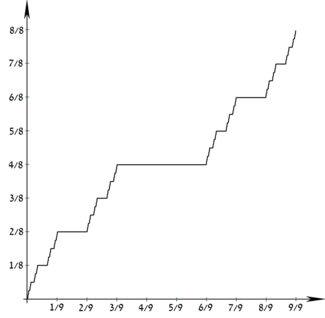Cantor distribution
|
Cumulative distribution function  | |||
| Parameters | none | ||
|---|---|---|---|
| Support | Cantor set, a subset of [0,1] | ||
| pmf | none | ||
| CDF | Cantor function | ||
| Mean | 1/2 | ||
| Median | anywhere in [1/3, 2/3] | ||
| Mode | n/a | ||
| Variance | 1/8 | ||
| Skewness | 0 | ||
| Kurtosis | −8/5 | ||
| MGF | |||
| CF | |||
The Cantor distribution is the probability distribution whose cumulative distribution function is the Cantor function.
This distribution has neither a probability density function nor a probability mass function, since although its cumulative distribution function is a continuous function, the distribution is not absolutely continuous with respect to Lebesgue measure, nor does it have any point-masses. It is thus neither a discrete nor an absolutely continuous probability distribution, nor is it a mixture of these. Rather it is an example of a singular distribution.
Its cumulative distribution function is continuous everywhere but horizontal almost everywhere, so is sometimes referred to as the Devil's staircase, although that term has a more general meaning.
Characterization
The support of the Cantor distribution is the Cantor set, itself the intersection of the (countably infinitely many) sets:
The Cantor distribution is the unique probability distribution for which for any Ct (t ∈ { 0, 1, 2, 3, ... }), the probability of a particular interval in Ct containing the Cantor-distributed random variable is identically 2−t on each one of the 2t intervals.
Moments
It is easy to see by symmetry and being bounded that for a random variable X having this distribution, its expected value E(X) = 1/2, and that all odd central moments of X are 0.
The law of total variance can be used to find the variance var(X), as follows. For the above set C1, let Y = 0 if X ∈ [0,1/3], and 1 if X ∈ [2/3,1]. Then:
From this we get:
A closed-form expression for any even central moment can be found by first obtaining the even cumulants[1]
where B2n is the 2nth Bernoulli number, and then expressing the moments as functions of the cumulants.
References
- ↑ Morrison, Kent (1998-07-23). "Random Walks with Decreasing Steps". Department of Mathematics, California Polytechnic State University. http://www.calpoly.edu/~kmorriso/Research/RandomWalks.pdf.
Further reading
- Hewitt, E.; Stromberg, K. (1965). Real and Abstract Analysis. Berlin-Heidelberg-New York: Springer-Verlag. https://archive.org/details/realabstractanal00hewi_0. This, as with other standard texts, has the Cantor function and its one sided derivates.
- Hu, Tian-You; Lau, Ka Sing (2002). "Fourier Asymptotics of Cantor Type Measures at Infinity". Proc. AMS 130 (9): pp. 2711–2717. This is more modern than the other texts in this reference list.
- Knill, O. (2006). Probability Theory & Stochastic Processes. India: Overseas Press.
- Mattilla, P. (1995). Geometry of Sets in Euclidean Spaces. San Francisco: Cambridge University Press. This has more advanced material on fractals.
 |

